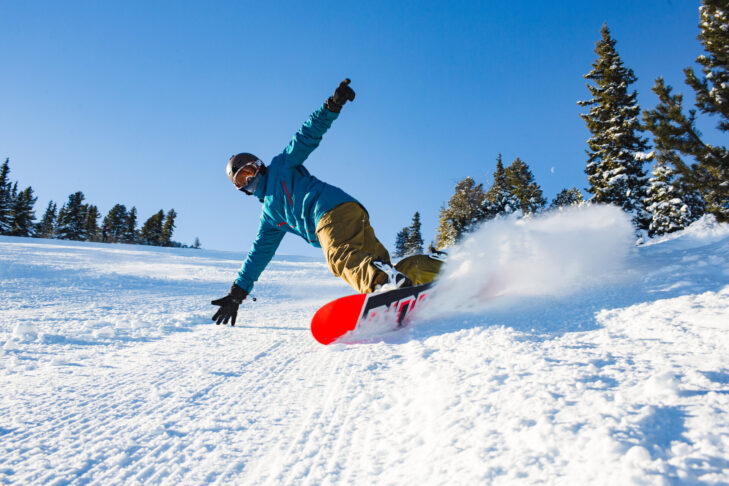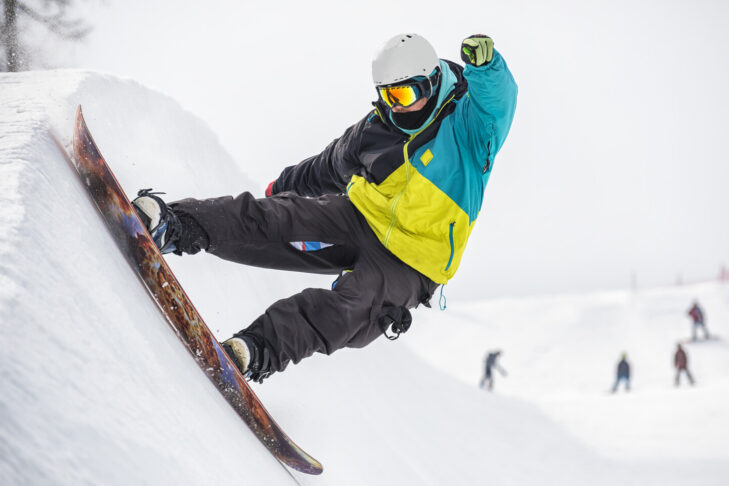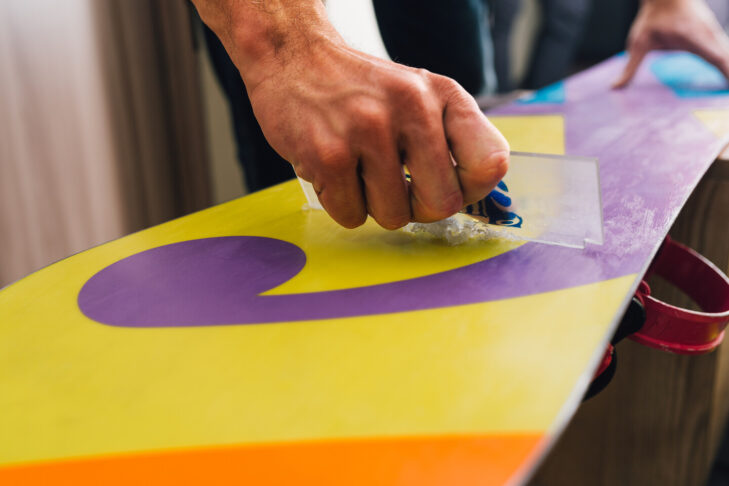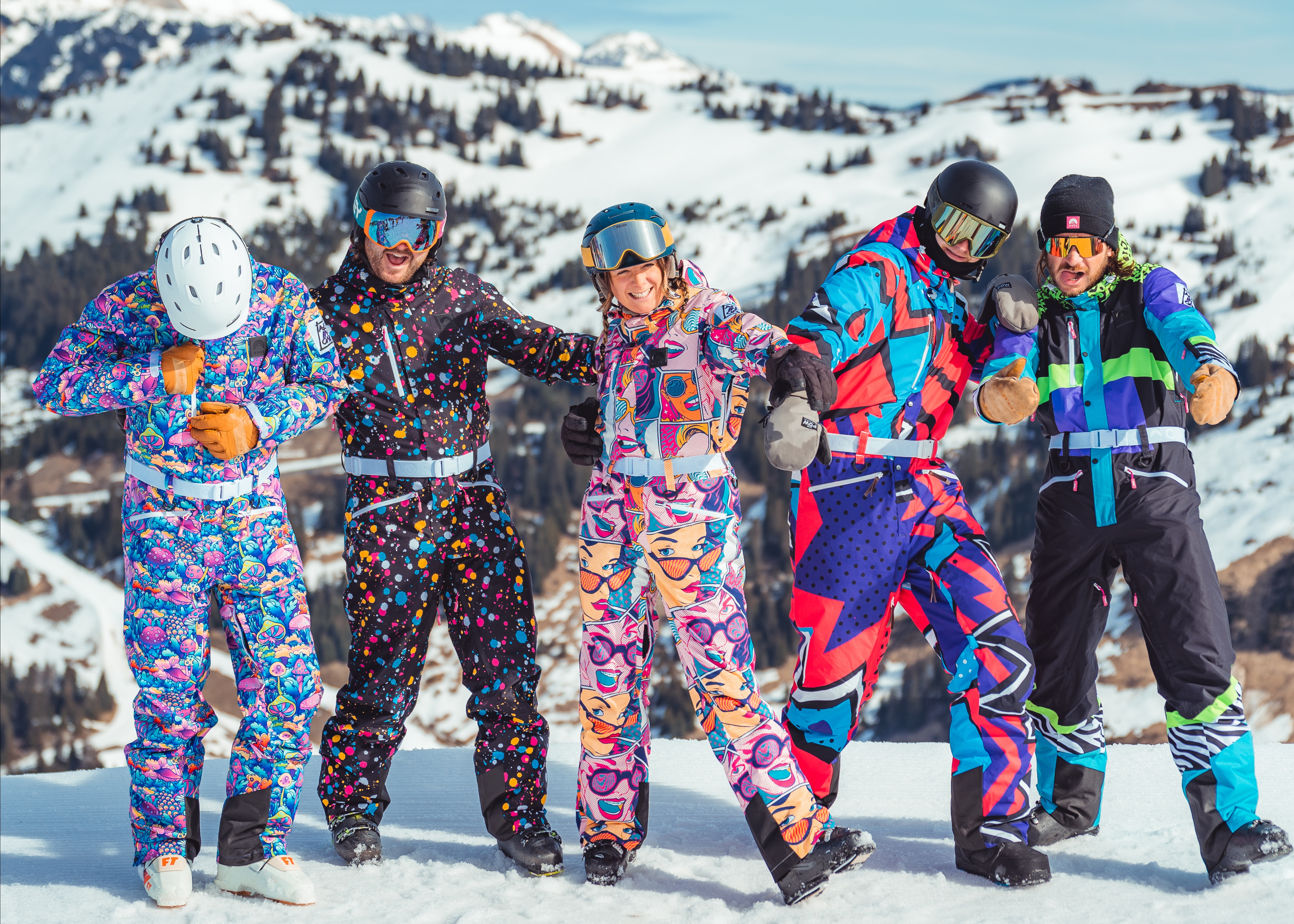Great weather in the sky, powder snow on the ground. Snowboarders dream of such conditions when they hit the piste in winter. But what does it take to carve down the slopes with a board under your feet and kick up some powder while freeriding? The answer is quite simple: the right snowboard equipment. SnowTrex provides a detailed to-do list showing exactly what snowboard equipment is needed and how winter sports enthusiasts should look after it outside the cold season.
Snowboard
As the name suggests, proper snowboard equipment first and foremost includes the right snowboard. And here, as in so many other areas, winter sports enthusiasts are spoilt for choice when it comes to the right equipment. After all, today there is a suitable board for every skill level and terrain. Snowboards are very similar in terms of their internal structure. They all consist of different layers that influence the riding characteristics depending on the material. Width, shape and the steel edges on the sides, on the other hand, differ considerably depending on the type of snowboard. Overall, the “board family” can be roughly divided into four different model types: All-Mountain, Freeride, Freestyle and Race.All-mountain snowboards are true all-rounders that can be ridden in any terrain – on and off the piste. This makes these boards particularly suitable for beginners and hobby boarders. They are easy to steer and, thanks to their design, forgive any riding mistakes more quickly. Advanced winter sports enthusiasts who prefer to take their board off the groomed pistes in the ski area should opt for a freeride snowboard. These boards are designed to provide as much lift as possible in powdery deep snow. They are longer and the tip of the snowboard, the “nose”, is wider. In addition, the rear binding is mounted further towards the tail. This allows the snowboarder to automatically shift their weight further back and prevents the nose from sinking into the snow.
Freestyle and race boards
Winter sports enthusiasts are of course really tricky on freestyle boards. Experts are able to ride these boards in the snow park as well as on the piste or off-piste. Freestyle boards are easy to recognise. This is because the nose and tail are shaped in the same way so that the board can be ridden in both directions. Overall, the models are shorter and softer. Although this means they are less forgiving of riding errors, they cushion landings after spectacular jumps and other tricks on natural or artificial obstacles better. Last but not least, raceboards offer pure speed on the piste. With these boards, which are significantly longer, harder and narrower than the other three types of snowboard, professionals and very experienced winter sports enthusiasts can really step on the gas on the piste. The flatter nose also creates less air resistance.
Snowboard binding
As with skis, the connection between winter sports enthusiasts and snowboards is the binding. And as with double slats, there are also different approaches to single boards for the piste. Snowboard bindings can be divided into five types: Soft, flow, chinch, step-in and plate bindings. Thanks to a uniform mounting standard in the form of a mount with four holes on the board, all five types of bindings theoretically fit on every snowboard. The only exceptions are the bindings from the world-famous snowboard manufacturer Burton, which is the only manufacturer to use a three-hole binding.
The best-known snowboard binding is the soft binding. With these models, the foot is stabilised at the back by a calf-high shaft, while the snowboard boot is fixed at the front in the area of the toes and instep by two ratchet straps. This type of binding is usually made of plastic or aluminium, with softer bindings – regardless of the five types of binding – allowing more control, while harder bindings offer advantages when carving thanks to more direct power transmission.
Flow, cinch, step-in and plate bindings
Flow bindings are similar in their basic construction, but differ significantly in the way they are entered and exited. As with soft bindings, the foot is secured at the front with two interconnected and closed straps. There is also a shaft at the back, the so-called highback, which is secured with two straps and a buckle. When the buckle is released, the shaft can be folded down and the snowboarder can slip their foot into it like a slipper. The buckle on the calf then closes again and the boot is firmly secured in the binding. A combination of soft and flow bindings is the chinch binding. It also has two fixed straps, but these can be tightened or loosened using ratchets. The shaft on the calf, which is connected to the binding plate on the board by two ropes, can be folded away with a buckle for getting on and off, as with the flow binding.
The following video explains what other types of snowboard bindings there are and how every winter sports enthusiast can find the right model for them:
Please also note that by using our services and integrating the YouTube API Services, the YouTube Terms of Service and the YouTube API Services Terms apply and your use of our website is deemed to be acceptance of these terms.
The two front straps, on the other hand, are completely omitted with the step-in binding. Instead, winter sports enthusiasts can simply “step in” with their boots, which have two metal pins on the right and left of the toe. These pins then engage in two springs, where they can be released again at the end. Like the other bindings, this type of binding also has a calf-high highback for stabilisation. In contrast, plate bindings have no shaft at all at the back. They are almost exclusively fitted to raceboards that are skied with hard boots – which are very similar to ski boots. In the binding, the boot is fixed at the back of the heel with a rigid metal bracket. A flexible metal strap with a safety buckle then folds over the toe at the front.
Snowboard boots
When looking for the right snowboard boots, winter sports enthusiasts are traditionally faced with the choice of two model types: Softboots and hardboots. The latter are similar to conventional ski boots with their outer shell made of sturdy plastic. However, they are designed to be more flexible so that the foot can move better in the boot. Hard boots are only used by raceboarders, as they only fit on plate bindings with their sole extensions on the heel and toe via two stirrups – almost like ski boots. All snowboarders who do not ride boards with plate bindings, on the other hand, use soft boots. These are softer in the truest sense of the word, have a normal rubber sole and are often fitted with laces so that they sometimes look like oversized hiking boots.
However, there are now also soft boot models that can be quickly “laced up” like ski boots with two or three plastic buckles. As with ski boots, a flex value is also given for soft boots, which indicates how easily the snowboard boot can be bent. The scale ranges from 1 to 10, with 1 to 4 being “soft”, 5 to 7 being “medium” and everything above 8 being “stiff”. Soft snowboard boots require less effort when steering the snowboard and are better padded, making them ideal for beginners and freestylers. Snowboard boots in the “medium” category, on the other hand, are more suitable for experienced hobby snowboarders who are also sometimes off-piste, as well as for ambitious freestylers, due to their greater stability. Winter sports enthusiasts who want to conjure up aggressive and tight turns in the snow on groomed pistes or are at home in deep snow as freeriders are more likely to choose models from the “stiff” category.
Snowboard goggles
No matter what the weather: the right vision on the piste is the be-all and end-all for winter sports enthusiasts. That’s why snowboarders should definitely look into the subject of snowboard goggles. After all, almost all products on offer in this area today no longer just protect against wind or sun. In step with the entire ski industry, the development of technically sophisticated and feather-light snowboard and ski goggles has also developed rapidly over the past few decades. So it’s no wonder that amateur winter sports enthusiasts can now customise the right equipment to suit their needs down to the smallest detail before almost every outing in the snow. They can choose from a wide range of frames, straps and lenses.
The lenses in particular are equipped with special anti-fog coatings that prevent fogging even in the event of major temperature fluctuations. Different polarised lenses also ensure the best vision in all weathers, which always fulfil their purpose even in dense fog, heavy snowfall or bright sunshine. This is particularly pleasing for snowboarders, who not only wear corrective goggles on the piste but also in everyday life and benefit even more from the technical features of the Googles. Thanks to their size and special fit, they often allow you to wear your own visual aid directly under your snowboard goggles without any pressure points. In addition, either the manufacturers or specialised opticians can grind the dioptres of the winter sports enthusiast into the lenses of the googles.
Snowboard helmet
In addition to classic snowboarding equipment, items that offer winter sports enthusiasts additional safety have become an absolute must on the piste in recent years. True to the motto: “You only have one head, so protect it”, a snowboard helmet absorbs the impact of even harmless falls and optimally dissipates the pressure wave via the shell construction. In this way, the winter sports enthusiast’s head is optimally protected from potentially life-threatening injuries.
As a result, colourful and sometimes very stylish helmets are becoming increasingly popular. Manufacturers must therefore continue to think innovatively here and gradually equip their products with additional functions, for example. Ventilation slits for optimum cooling of the head, warming earmuffs and real high-tech features such as Bluetooth modules have become indispensable. The latter allow snowboarders to communicate with other winter sports enthusiasts on the piste via headphones with a microphone or to listen to music during the descent via a wireless connection to their mobile phone. However, the main function of the helmet is still to protect the head and not the design. This is why all products in this area must comply with international safety standards. If you want even more safety, you can now opt for a helmet with complete face and chin protection.
Back protectors
What are protectors actually? In short, they are protective pads that protect snowboarders from injury, even if the fall looks harmless. Back protectors are particularly popular in this market segment, protecting the spine from knocks and bumps like the shell of a tortoise. In addition to individual protective pads, there are also breathable protector jackets available today. These are usually designed so that they can be worn under a ski jacket and already have all the safety functions of a normal protector integrated. Some snowboarders also opt for padded trousers that protect the thighs, hips and coccyx in the event of a fall on a hard and icy piste. Elbow and knee protectors are also offered by manufacturers, but are less popular as they restrict mobility on the board to some extent.
Snowboard care
Experienced winter sports enthusiasts know: The best snowboard equipment is useless if the material is not in good condition. When it comes to caring for your own snowboard, waxing the gliding surface and sharpening the edges are the most important things to do. Firstly, however, all snowboard equipment must be kept clean and freed from salt, snow and dirt after every day of skiing. It is then advisable to store the board and boots in a warm place, such as a ski cellar. Before and after the ski season, it is also worth taking all your snowboard equipment to a specialist dealer, who will check the equipment and repair it if necessary. You should also make sure that the inner boot of your snowboard boots is completely dry before storing them in the cellar, for example. This is the best way to prevent wear and mould growth.
Another point to bear in mind is the cleaning of snowboard goggles. Because if you love your expensive goggles, you should never wipe them with a handkerchief or even your jacket! After all, the delicate coating will quickly become scratched. Instead, it is advisable to simply clean the outer lens with lukewarm water and then leave the glasses to air dry. Once this condition is reached, the googles are carefully dabbed with a microfibre or glasses cleaning cloth. However, water is not sufficient for cleaning snowboard clothing, which is why there are special detergents for jackets and trousers. They should therefore be put in the washing machine separately from normal washing. After drying, the fabric must be impregnated on the outside.
Snowboard storage
Almost everyone knows that there are only a few materials in the world that really last forever. Things like cars, kitchen appliances or clothing that are regularly used or worn in everyday life need to be looked after again and again. This is the only way they can give their owners pleasure for a long time. The same also applies to items that are not used so often. Snowboarding equipment, for example, which has to withstand the extremes of the elements as well as heavy loads such as impacts during the season. Regular snowboard care is therefore essential in order to withstand both cold and wet conditions and to allow the snowboard equipment to survive the summer. So after a long day on the piste in the mountains, it’s time to dry your snowboard and boots properly before giving them a good going over at the end of the season at the latest.
At home, snowboard clothing is either washed in the washing machine or taken to a specialised dry cleaner, while snowboard boots need to be cleaned of moisture, dirt and road salt residue before the summer break. If necessary, treatment with an anti-mould spray is also recommended. For the snowboards themselves, microfibre cloths, washing machines and special sprays quickly reach their limits and sometimes don’t help at all. It is therefore important that the snowboard material is treated before storage, either by the winter sports enthusiast themselves or by a specialist. This means first removing coarse dirt from the boards and drying them. If you don’t have a suitable tool for the steel edges to hand, you should go straight to a specialised shop. There, trained staff will then use an edge grinder to make the necessary corrections to prevent unwanted flash rust, for example.
Storing snowboard equipment correctly in summer
Winter sports enthusiasts who have ticked off all these points store the parts of their own snowboard equipment such as clothing, gloves, helmet and snowboard goggles in a cupboard. The boots and snowboard, on the other hand, belong either in the attic or in the cellar. Where it is dark and, above all, dry. In contrast, storage in garages or garden sheds is not suitable. Due to the strong temperature fluctuations, especially in summer, there is a risk that condensation will form in the pockets in which the equipment is best stored and the metal will eventually start to rust.
Hire or buy snowboard equipment?
Every winter sports enthusiast who is not on skis on the piste knows that a snowboard, the right boots and a protective helmet are not exactly easy to transport due to their size and sometimes also their weight. Not to mention the fact that your own high-quality snowboard equipment can quickly cost over 1,000 euros. So it’s no wonder that many snowboarders ask themselves one question almost every winter: Hire or buy snowboard equipment?
There are two main arguments in favour of renting snowboards: Firstly, the equipment is usually top of the range and secondly, ski shop staff always carry out thorough maintenance on the snowboards. And this is where another advantage of hiring comes into play. In summer, when snowboarders hardly use their boards anyway, they don’t have to look after them themselves and therefore don’t spend a single euro on it. The situation is different with purchased snowboards. Here, winter sports enthusiasts have to take care of the maintenance themselves and pay for it.
With the second option, however, they are also in the comfortable position of benefiting greatly in one area. After all, the snowboard is only used when the owner takes it out on the piste. This protects the material and extends its service life – in contrast to rental boards, which are in constant use throughout the winter season. What applies to boards as part of snowboard equipment for beginners also applies to snowboard boots. Like helmets, they can be hired from well-stocked specialist shops in every ski resort. However, not all snow fans like this service. The reason: nobody knows exactly how many other, unfamiliar snowboarders have already had this equipment on their feet or heads.
FAQ on snowboard equipment
How long have snowboards been around?
The “snowboard” phenomenon slowly spread to ski resorts around the world in the mid-1980s and is still an integral part of the slopes today. The original snowboard was invented by Austrian Toni Lenhard in 1900 with his monoglider. In the 1960s, the boards were first commercialised by surfer Sherman Poppen and then two years later by the snowboard pioneer par excellence, Jake Burton, in the USA.
What do you need to ride a snowboard?
Winter sports enthusiasts who want to snowboard on beautifully groomed pistes or in deep snow in winter need at least five items of equipment: firstly, of course, a snowboard with the right bindings, suitable snowboard boots, a high-quality and, above all, well-fitting snowboard helmet and snowboard goggles. And if you literally want to be on the safe side, put on a back protector under your warm snowboard clothing. This should consist of gloves, a snowboard jacket and snowboard trousers.
How much does complete snowboarding equipment cost?
A winter sports enthusiast’s own snowboarding equipment can cost at least 1,000 euros and more. Good snowboards, whether new or partly used, can cost between 300 and 600 euros, a pair of snowboard boots between 100 and 200 euros. Snowboard bindings can also cost up to 200 euros. Real bargain hunters can budget between 150 and 300 euros for the rest of the equipment (jacket, trousers, gloves, helmet and goggles), but it can also be considerably more expensive.
Which snowboard equipment is worth buying?
When it comes to the parts of snowboard equipment that are absolutely worth buying, it is mainly the closeness to the body that plays a role. In other words, snowboard clothing such as jackets, trousers and gloves, which usually come into direct contact with the skin, should be bought first for reasons of hygiene. The same applies to the snowboard helmet, which encloses the head, which also sweats a lot in winter, on the piste. It can also save lives in the event of a fall and must therefore fit perfectly. As the shape of the goggles should fit into the front of the helmet to prevent unpleasant icy wind from hitting your face through any gaps, we also recommend buying them rather than renting them.
Which snowboard is suitable for beginners?
When looking for the right snowboard, beginners initially opt for one of the popular all-mountain snowboards. These are real all-rounders that can be ridden in any terrain, on and off the piste. Thanks to their special construction, these snowboard models are also easy for beginners to master. Apart from that, their construction means they are also quick to forgive small riding mistakes.







